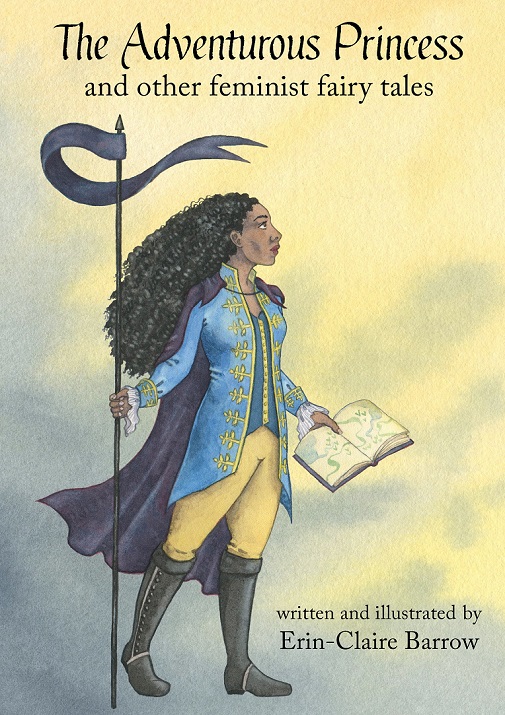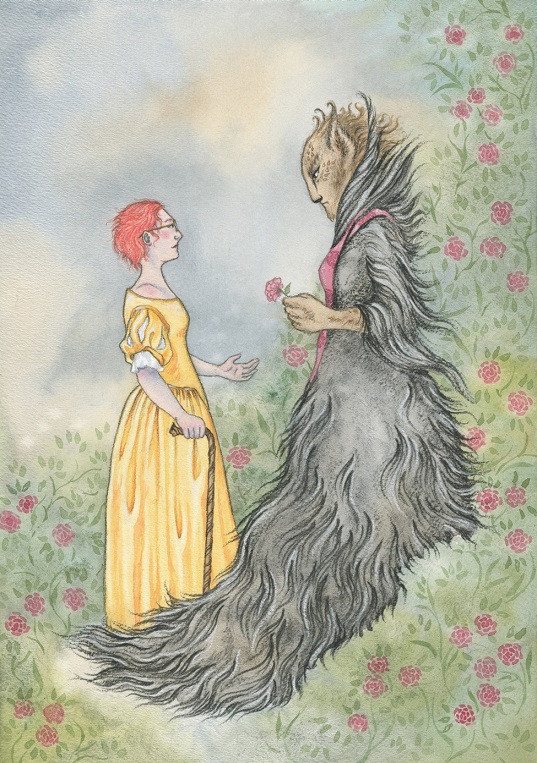Help me welcome Erin-Claire Barrow as today’s Wednesday’s Guest. She has written and illustrated the delightful book, The Adventurous Princess and other feminist fairy tales, which I reviewed here this past Sunday. This is a long post, but it’s all quite interesting, especially the history of fairy tales and the men who first wrote them. 🙂
 Hi Maryann, thank you so much for having me here, it’s a real pleasure to chat with you about the book, and thank you for your thoughtful review! I’m so glad you enjoyed the exchange between Ella and her fairy godmother in Cinderella, that was a scene I particularly enjoyed writing.
Hi Maryann, thank you so much for having me here, it’s a real pleasure to chat with you about the book, and thank you for your thoughtful review! I’m so glad you enjoyed the exchange between Ella and her fairy godmother in Cinderella, that was a scene I particularly enjoyed writing.
Q. First, I have to say your book was a delight to read. How did you come up with the idea to write the fairy tales with a feminist twist? Do you have an agenda?
A. That’s an interesting choice of words, because it is arguably impossible to tell stories without an agenda of some kind, and people have been retelling fairy tales with many different agendas for hundreds of years. From the 16th to the 19th century, fairy tales were deliberately retold, sometimes in written form for the first time after being an oral tradition for hundreds of years, with a focus on prescribing how people, and children in particular, should behave. Authors also used fairy tales to critique powerful people and institutions, as well as social norms. For example, the subtle critique of the French Court of Louis XIV by late 17th century fairy tale authors, or Madame de Villeneuve’s critique of restrictive marriage practices in her original version of Beauty and the Beast.
I have always loved fairy tales, but many of the traditional ones I grew up with, from the Grimm brothers, Charles Perrault, and Hans Christian Andersen – through to Disney, don’t truly represent the society we live in today. The heroes of these stories are usually either expressly, or implicitly, straight, white, young, able-bodied and conventionally beautiful. In addition, many of the tales reinforce traditional gender roles and stereotypes, with women being rewarded for their beauty, obedience, and passivity, while men are rewarded for taking risks, being brave, clever, and active.
Today we recognise the diversity within our society and value equality in a way that wasn’t the case when many of these fairy tales were written. In my book, I’m continuing a long tradition of retelling fairy tales to fit the norms and values of the current time. Through this book, I hope more people will be able to see themselves represented in fairy tales.

Q. Why did you choose these nine fairy tales in particular?
A. I chose them for two reasons. First, I hoped readers would recognise them and enjoy the twists in these retellings. Second, I chose tales that had always sat a little uneasily with me because of the expectations placed on women to be obedient, beautiful, and gentle, with little opportunity to actively change their own stories. A resolution is largely achieved because the woman is the passive recipient of someone else’s ability to resolve the central conflict of the story, often through marriage, and there were sometimes undertones of sexual violence.
For example, in “Allerleirauh”, the hero of the traditional fairy tale first runs from her father, then is reluctantly revealed to another King who declares his intention to marry her regardless of her attempts to pull away or to hide her identity. In the “Swan Maiden”, the title character is kidnapped by a huntsman who immediately marries her because of her beauty; she is forced into a relationship against her will and escapes as soon as the opportunity presents itself.
The Princess from “The Princess and the Pea” is delicate to the point of ridiculous, her only purpose is to prove that she is royalty by being unsuitable to be anything else. The story never questions whether the Prince’s desires align with those of his parents, who want him to marry a delicate princess, much less whether the Princess wants to marry the Prince.
Interestingly, if you consider the history of retelling fairy tales, these characters have not always been depicted this way. Cinderella was a much more active hero before Charles Perrault retold her story in 17th century France. He had very particular ideas about how women should behave – they should be obedient, gentle, and focus on their beauty and how they could best support and please their husbands.
Q. Will there possibly be more fairy tales to come?
A. I hope so! I would be interested to explore a more adult retelling of fairy tales, exploring the subversive potential and darker themes of the traditional stories a little further.

Q. If you could go through a wormhole, would you go into the future, the past, or stay right here? Why?
A. Although I worry that it might be very bleak, I would love to go into the future. I wish I could jump forward a few hundred years, spend a while there getting to know what’s happened, and then jump forward again. I’m eternally curious about what comes next!
Q. Have you always wanted to be a writer, or have you come to writing after another career? What was that career?
A. I’ve always loved writing, but I’m also an illustrator and much more of my time is spent on illustration than writing. Having said that, neither of these is a full-time career – I’ve always worked full time in other jobs while illustrating and writing. I currently work in policy around supporting vulnerable children and families. I hope one day the illustration or writing will be a full-time career, but I suspect that day is still a while off!
Q. What is your family’s favorite story to tell on you?
A. When I was little, I was playing outside with my younger brother, and came running into the house screaming for mum to come quickly. Mum thought something terrible had happened to my brother and raced outside. It turned out I wanted to show her the beautiful sunset before it disappeared!
Q. What other creative things do you do?
A. I love to paint watercolour illustrations. If I had all the spare time in the world I’d love to practice my digital art and my acrylic painting. There are so many things to learn and experiment with!
Q. What do you do for fun?
A. I really love hiking and getting out to wild places, the wilder the better! I am fortunate that I live within an hour or so drive from some really lovely mountain wilderness, with stunning scenery and challenging hikes. My favourite walk has a lyrebird halfway up the mountain who is always singing, except when it snows!

Q. Do you have a pet?
A. I feel like I need to prove I can keep a plant alive for more than a few months before I can trust myself with a pet! I am currently working hard looking after one little fern and a tiny lichen garden that was a present from my scientist sibling.
You can find out more about Erin-Claire and see her wonderful artwork on her WEBSITE * Visit her on FACEBOOK ** TWITTER ** INSTAGRAM & TUMBLER
